 |
Research Program
Program A01
|
 |
Leading Researcher: |
OKINO, Kyoko (ORI, Tokyo univ.)
|
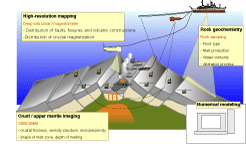
|
|
Objective:
|
Team A01 aims to demonstrate a link between the geophysical/geochemical structure around vent sites and the hydrothermal ecosystem.
|
|
Research Plan:
|
Main target areas are the southern Mariana Trough, where three unique "arc/backarc surfer Taiga"s align across the backarc rift axis and the Central Indian Ridge, where a "hydrogen Taiga" and a "MOR type normal surver Taiga" exist apparently same morphological setting. We planned to map these areas, from surface geology to upper mantle, and to collect rock samples, trying to reveal what controls the diversity of hydrothermalism. The heat source, circulation path and the difference of host rocks should be elucidated. |
|
Methods
|
State-of arts AUVs will be used for surface mapping, including sonars and magnetometers, Dozens of OBSs and OBEMs will be deployed for deep crust/ upper mantle imaging. Manned submersibles will be also used to collect samples as well as dredge and rock cores from surface ships. Numerical simulation of hydrothermal circulation will be integrated with the observational results.
|
|
| Thema A02: Biogeochemical impact of TAIGA flux to deep sea environment |
 |
Leading Researcher: |
SUNAMURA, Michinari (Graduate School of Science, Tokyo univ.)
|
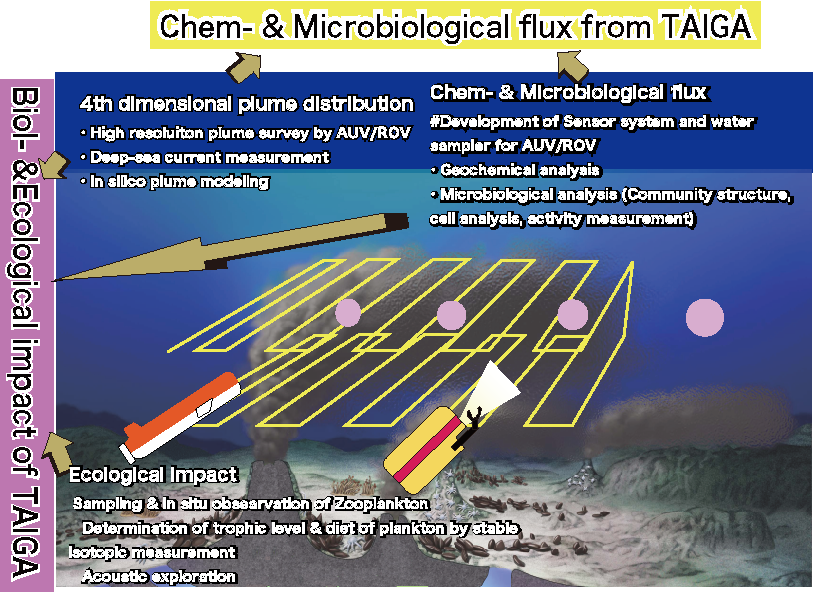
Method:
Sample collection: Water samples collected mainly by CTD-Niskin sampler, but also an AUV and/or ROV equipped with a water sampler system will be deployed during research cruises.
In situ sensors: Several sensors, CTD-DO, turbidity meter, chemical sensors (pH/ORP, ISFET pH, H2S), are set on the AUV or ROV to detect the signature of thermal plumes.
Onboard study: Flow cytometer is installed in the onboard laboratory to determine the counts of microbes and viable cells immediately after sample collection, in order to improve data quality.
Simulation model: Computed simulation model provides visible image of time and space structure, which may be impossible to re-construct only using in situ data.
|
|
Objective:
|
Research target of the team A02 is hydrothermal plumes of hydrothermal systems. Comprehensive investigation of geophysical, geochemical, and microbiological phenomena in the plume will help elucidate the biogeochemical impacts of TAIGA flux to the surrounding marine environments.
|
|
Research Plan:
|
Okinawa Trough, southern Mariana Trough, and Indian Ocean Ridge, are major target areas for this study, due to their combination of specific traits according to their geological settings . Biogeochemical analyses of the plume sample, in situ measurement of physico-chemical factors using several sensors, and deployment of an autonomous underwater vehicle (AUV) are basic ideas to develop high resolution profiles of plume structure. Onboard measurement of microbial cells is planned to estimate their viability and population size. A simulation model analysis combined with the in situ observations will be carried out to improve understanding on the nature of the hydrothermal plume. |
|
|
|
|
|
| Program A03 : Evolution of TAIGA - constraints from geochronology and molecular genetics |
 |
Leading Researcher: |
Ishibashi, Jun-ichiro (Faculty of Science, Kyushu Univ.) |
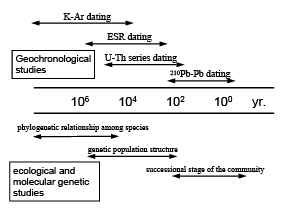
|
|
Objective:
|
Team A03 aims to develop methodologies to estimate ages of hydrothermal events and phenomena, those are helpful when investigating the evolving processes of TAIGA systems.
|
|
Research Plan:
|
We are planning to investigate two approaches; one is geochronological studies of hydrothermal deposits and alteration minerals, and the other is ecological and molecular genetic studies of animals obligating to hydrothermal vent fields. Comparison of age determined by these quite different approaches would provide much reliabile ages. Our main target is hydrothermal fields in the southern Mariana Trough, which are expected to have experienced drastic evolving process of "arc/backarc surfer Taiga". |
|
Methods
|
(1) We are planning to investigate application of various geochronological techniques to minerals formed by seafloor hydrothermal activities, such as K-Ar dating of alteration minerals (for 104 - 107 years), U-Th series disequilibrium dating of sulfide/sulfate minerals (for 102 - 104 years), ESR (electron spin resonance) dating of barite (102 - 105 years).
(2) We are planning to estimate the date of establishment of animal communities obligating to hydrothermal vent in three time scale with three methods; classifying successional stage of the local community (for 100 - 102 years), that of foundation of local populations age by revealing the genetic population structure of each species (for 103 ? 104 years), and that of deviation between sister species by analyzing phylogenetic relationships among species (for 105 - 106 years).
|
|
| Program A04: Clarification of in situ physical, chemical and biological interactive processes in TAIGA |
 |
Leading Researcher: |
TAKAI, Ken (SUGAR Project and PEL, JAMSTEC) |
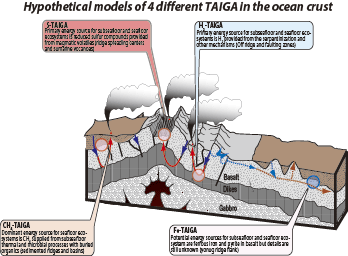
|
|
Objective:
|
A variety of physical, chemical and (micro)biological interactions are predicted in the whole TAIGA steps. Particularly in 4 hypothetical TAIGA models (H2-TAIGA, S-TAIGA, CH4-TAIGA and Fe-TAIGA), fundamental micro-scales of interaction processes between solid (rocks and minerals), fluid (water, solutes and gas) and life (microbial communities) are clarified by in situ, onboard and onshore observations, analyses and experiments. Integration of these fundamental processes will provide a general insight into elucidation of the global TAIGA system. |
|
Research Plan:
|
Multi-disciplined scientists (geomicrobiologist, organic and inorganic geochemists, isotope biogeochemists, mineral geochemists, engineers) in Japan are synergically working for this program. Specific TAIGA targets are a deep-sea hydrothermal field in the Okinawa Trough (CH4-TAIGA, scheduled IODP expedition in 2010 and 2011), adjacent deep-sea hydrothermal fields in the Mariana Trough (S-TAIGA, BMS drilling expeditions in 2010 and 2011), deep-sea hydrothermal systems in the Central Indian Ridge (H2- and S-TAIGA, seafloor observations in 2009 and 2011), submarine volcanoes in the Mariana Arc and IODP expedition in MAR (Fe-TAIGA). |
|
Method: |
A combination of biogeochemical techniques and methods are applied to in situ, onboard and onshore observations, analyses and experiments. Liquid- and gas-chromatography with mass spectroscopy, isotope-ratio mass spectroscopy, SIP- and RIP-tacer experiments, XANE and XAFS techniques, Nano-SIMS, ICP-AES and ?mass spectroscopy, Neptune mass spectroscopy, meta-genomic, -transcriptomic, -proteomic and -metabolomic analyses and etc. are devoted to resolve the processes. The results are also justified by stoichiometric, thermodymanic and kinetic calculations. The quantitative estimation of the processes to the whole energy and material fluxes is one of the research goal in this program.
|
|
|
| Program A05: Laboratory experiments to elucidate chemical and biological interactions in TAIGA |
 |
Leading Researcher: |
SUZUKI, Katsuhiko (JAMSTEC) |
 |
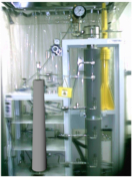 |
|
Objective:
|
Team A05 aims to reproduce processes using high-pressure and high-temperature experimental apparatus in the laboratory to constrain the chemical and biological interactions. |
|
Research Plan:
|
We can obtain the in-situ physical, chemical and biological properties of TAIGA by research cruise and by on-land analyses of the samples collected in the cruse. However, the areas we can observe by research submarine is extremely limited. Also, it is difficult to observe the change of the reaction in TAIGA. Laboratory experiments possibly allow us to cover such matters, because we can control the pressure and temperature of the reactions among rocks, hydrothermal solutions and microbe in laboratory experiments. Also, we can use various kinds of reactants (types of rocks, chemical compositions of the solutions, and so on). We utilize such advantages of the laboratory experiments to elucidate the chemical and biological interactions in TAIGA. |
|
Method: |
Dickson-type (batch-type) hydrothermal experimental system, flow-type hydrothermal experimental system, ICP-AES, ICP-MS, Gas chromatograph, ion chromatograph
|
|
|
Public offering Research Program
Numerical study on hydrothermal plumes and material diffusion in a submarine flow field (correlate with Program A02)
Leading Researcher: FUKUNISHI, Yu (Tohoku Univ.)
In order to investigate the material advection and diffusion driven by hydrothermal plumes, the submarine hydrothermal convection is studied by the numerical simulation. We apply a high-speed high-resolution computation scheme for the modified incompressible Navier-Stokes equations for a stratified thermal convective flow. Submarine hydrothermal plumes and the flow affected by ocean currents, submarine topography and Coriolis force, are also studied to clarify the overall nature of submarine flows.
|
 |